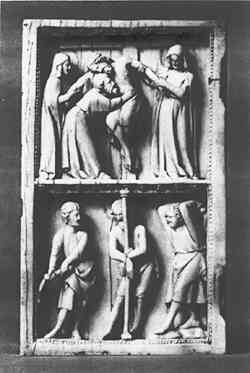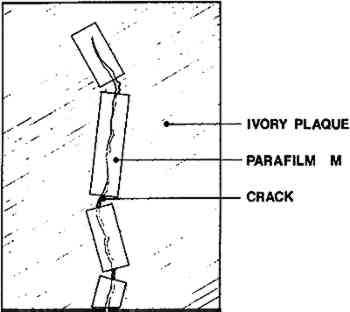A METHOD FOR REINFORCING FRAGILE IVORYTerry Drayman Weisser
The Walters Art Gallery has approximately 1157 ivory objects in its collection. Faced with the problem of preparing several fragile ivories for travel, I became acutely aware of a lack of published information on this subject.2 The ivories to be lent included a late Roman plaque (5cm by 5.9cm) and two French 14th century plaques (11.6cm by 6.9cm, as shown in Figure 1; 10cm by 17.2cm) which had cracks extending almost their entire lengths. Due to warpage, the ivory on either side of the cracks did not meet at the same level: one side was higher than the other. The front surfaces of the plaques were carved in relief while the reverse surfaces were polished smooth. The minimum thickness of the ivory was three millimeters.
Although these ivories should have been kept in a controlled environment and not lent at all, unfortunately, this was not a possible alternative. Therefore, a method had to be found which would reinforce the cracked ivory plaques structurally while not restricting their movement when subjected to fluctuating relative humidities encountered during travel. Ivory is a complex material and its composition and properties eliminate many forms of treatment from the start. Ivory is a mineralized collagenous matrix consisting mainly of calcium phosphate hydroxide 3Ca3 (PO4)2 � Ca(OH)2. Depending on its age and state of preservation, ivory contains varying amounts of organic material, mainly the fibrous protein collagen, with smaller amounts of elastin, mucopolysaccharides and lipids. Therefore, alkaline and acidic solutions, organic solvents, and alcohol and water may be detrimental to the structure of ivory or cause leaching of its constituents. Also, changes in relative humidity and temperature can lead to physical damage such as cracking or delaminating. Additional factors must be taken into account when applying any supporting material to the surface of ivory. The material must be flexible enough to follow extreme changes in the ivory's contours and the adhesive must be strong enough to adhere firmly to the surface. A material which initially adheres may eventually peel or shear away since ivory surfaces are often polished either intentionally or from wear. Several materials were considered for reinforcing the cracked ivories. Adhesives containing solvents which might leach the constituents of the ivory, or any material requiring such a solvent for its removal, could not be used. Dry methods seemed to have the most potential. Heat-set materials such as crepeline impregnated with various PVA emulsions, Promatco Heat Set Tissue and Promatco Mounting Tissue, both alone and in combination with crepeline, were tested. They were applied with a heated spatula on a piece of test ivory. The PVA-impregnated crepeline, heat-set tissue and mounting tissue appeared at first to adhere well, but could be removed easily from the polished surface by gentle lifting. Since it was feared that accidental removal might occur during handling, these methods were discarded. Parafilm M, a highly flexible thermoplastic film composed of butadiene, polyethylene and a paraffin wax, usually used to seal laboratory glassware, was tested as a reinforcement for the ivory. This film is available in rolls with a paper interliner to prevent it from sticking to itself. If stretched lengthwise at room temperature, it increases approximately 200% and will return only partially to its original dimensions when the tension is removed. It is a product of the American Can Company and can be purchased from laboratory and chemical supply companies. On a test ivory, a 2.5cm by 1cm strip of Parafilm M was applied over a crack with the longer dimension of the strip running parallel to the crack. A small heated spatula was Of the materials tested, Parafilm M had the most desirable qualities for the reinforcement of cracked ivory. It could be applied with a slightly warmed spatula with virtually no Parafilm M was used to reinforce the three ivory plaques mentioned above, as well as several cracked plaques of bone. The plaques were well supported and cushioned from the front while the Parafilm M was applied to the reverse. The treatment was easily and quickly accomplished using a warm spatula and strips of Parafilm M (approximately 2.5cm. in length and 1 cm in width at .5cm intervals) placed longitudinally over the crack3, as shown in Figures 2 and 3. Silicone release paper was used between the Parafilm M and the spatula, which was never allowed to rise above 38�C.
Some of the plaques reinforced with Parafilm M have now returned from traveling. The Parafilm M is still well adhered to their surfaces, and the cracks have not progressed. Although this treatment has been successful on ivory of at least 3mm thick, I must stress that it is not recommended for thinner pieces such as painted ivory miniatures, since the pressure and heat required, although very slight, might lead to warping or other damage. REFERENCESDirector of Conservation and Technical Research, The Walters Art Gallery, Baltimore, MD. Meg Loew Craft is presently doing work on the treatment of ivory in the conservation laboratory at The Walters Art Gallery. Parafilm M can be applied in a continuous strip if the crack is straight and the surface is fairly regular. a: References  Entire Article Entire Article |


